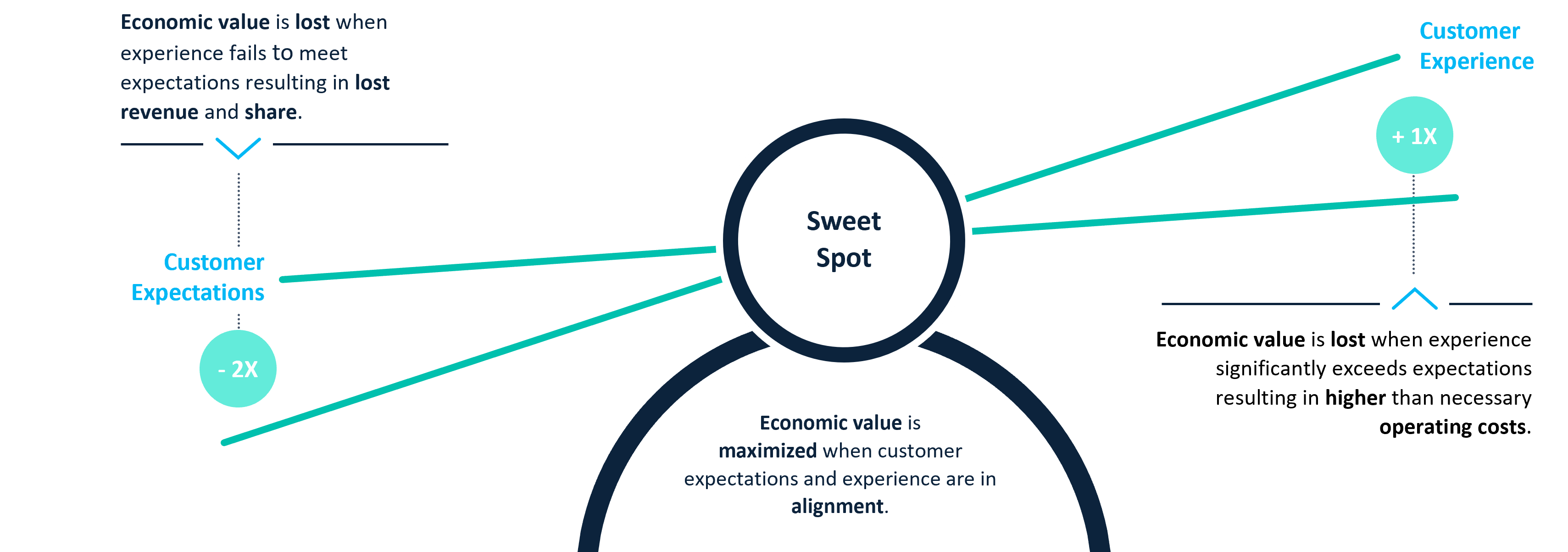The last piece of the value puzzle - Quantify the ROI of Customer Experience (CX)
Drive business value by maximizing use of customer insight and data-driven prioritization of CX initiatives

“4 in 10 VoC and CX measurement programs fail to measure the effectiveness and efficiency of their own program. VoC and CX leaders can’t count on their organizations continuing to fund these programs if they don't show value. Faced with economic headwinds, CX teams need to focus on showing ROI now more than ever.” 1
The link between an organization’s investment in customer experience (CX) and financial performance has been challenging to document and often ignored as companies seek to grow only on core CX metrics like NPS or CSAT. However, CX needs to be more than a point of differentiation: it needs to be a source of profitability and demonstrate return on investment.
Organizations need to invest in CX to find the “sweet spot” where experience delivered meets expectations. Underdelivering on CX causes organizations to lose market share and revenue. Overdelivering on CX results in organizations losing economic value due to inefficient investments.
A CX Economics model can help an organization find the optimal investment levels and quantify the expected return on investment for CX initiatives. This will help drive CX programs to the next level and will build momentum and alignment behind CX across the organization.

Quantifying ROI can serve as both a justification of past CX spend and a business case for future spend based on historical returns. It also serves as a prioritization tool to help ensure highest-impact CX initiatives are prioritized on your roadmap.
Why this is important for your organization
It is not enough to track customer metrics. Organizations need to take the next step and connect the data across systems to build a full view of customer lifetime value (CLV). By quantifying the value of each customer, organizations can understand key CX levers that drive customer lifetime value and can assess the impact of initiatives on those levers. For example, for one of our clients, we quantified a 135% ROI on a CX transformation program by evaluating the program’s impact on churn, interaction cost, cross-sell, up-sell and other key business metrics. This has allowed our client to justify future CX investment and gave them a model to project future ROI to guide prioritization of CX initiatives.
How organizations can start thinking about CX Economics:
1
1. Understand customer lifetime value to put the customer at the center of every decision
Customer-obsessed organizations need to evaluate their customer’s value over time and understand what levers to pull to incrementally drive customers toward behaviors that increase their lifetime value. These levers can be understood based on a full view of customer touchpoints. Incorporating behavioral elements such as referrals, expected loyalty, and other factors is essential to ensure decisions are made with a holistic understanding of customer impact.
- What is the lifetime value of a promoter versus a detractor?
- All my customer data is coming from different places – how do I understand the total value of a customer?
2
2. Prove the value of CX
Quantify the real financial impact of CX initiatives based on changing customer behaviors and corresponding impact to the customer lifetime value. Showing the close connection between CX and ROI will help serve as an ongoing justification for CX and will align leadership and cross-functional teams.
- How can I justify my past CX transformation investment?
- What did my X point increase in NPS mean for my business in terms of ROI?
3
3. Empower your organization to action on customer feedback and drive cultural change toward customer-centricity
Having a shared understanding on how CX drives business value across departments helps unify your organization behind CX. Impact-based decision making must be embedded cross-functionally to drive action on customer feedback in a consistent, profitable way. Insights need to be delivered in the right place, in the right format, at the right time, and formulated to incentivize action.
- Who is accountable for CX action within each business area?
- How can I get marketing, sales, and service to all support a CX initiative?
- How can customized customer dashboards help cross-functional teams act?
- How can insights be delivered in the most effective manner?
- How can I demonstrate the value of taking action?
By tying the impact of CX initiatives to business and financial outcomes through a robust and tailored CX Economics model, organizations can intelligently and efficiently invest in improving the customer experience. This can be applied more broadly across customer-facing initiatives using CLV-driven ROI as a guide to prioritize investment across functions. Organizations can drive customer engagement, advocacy and loyalty through initiatives that improve short- and long-term company value.
Quantifying the ROI of Customer Experience is the missing piece of the value puzzle, bridging the gap between customer insights and financial success. By embracing CX Economics, organizations can unlock the power of data-driven decision-making, prioritize impactful initiatives, and transform customer-centricity into a catalyst for profitability.
Additional KPMG Customer Advisory perspectives on quantifying the value of customer obsession can be found here.
How can KPMG help?
KPMG Customer Advisory helps some of the world's leading marketing, sales and service professionals make the right technology and operational investments that deliver meaningful, sustained growth. KPMG demonstrates value with VoC program strategy and execution and has quantified ROI of VoC and CX investments for clients across industries.
Footnotes
- Source: Business process incubator, “Good News/Bad News About VoC and CX Measurement Practices”, Authors: Colleen Fazio, Maxie Schmidt-Subramanian (December 6, 2022).
Explore more
Break out: From ordinary to extraordinary
Results from the 2022 US Customer Experience Excellence Report
Meet our team

